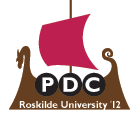| EXPL PAPERS | WEDNESDAY 14:00-15:00 | SMALL AUDITORIUM |
Values and Politics
Session chair: Christina Mörtberg, Linnaeus University
Mapping design practices: On risk, hybridity, and participation
Liesbeth Huybrechts, Social Spaces, Media, Arts & Design Faculty, Genk
Katrien Dreessen, Social Spaces, Media, Arts & Design Faculty, Genk
Selina Schepers, Social Spaces, Media, Arts & Design Faculty, Genk
Abstract. In this paper we reflect on MAP-it: a participatory mapping method and toolkit, containing a map, sticker sheets, a scenario, etc. It enables designers to moderate participatory design processes through workshops in which people from different backgrounds collaboratively reflect on and set up new projects. In several test mappings during our research, we observed that participants in participatory contexts were often too eager to please the group. Furthermore, especially ‘makers’ – being designers, engineers, etc. – had difficulties with releasing control over the participatory process, thus allowing the process to evolve in unexpected ways. This led us to conclude that MAP-it should encourage participants to take risks in the participatory process. Our research identified three types of risk-taking in participatory design processes, which we integrated in MAP-it. First, MAP-it allows people to express their differences in opinions. Therefore it is deliberately created as a hybrid form, borrowing elements from various disciplines, methods and media. Second, it permits making friction between participants explicit by using ‘risk-stickers’ and game rules. Finally, its open characteristics force the designer and participants to give up a part of their control over the design process.
Co-constructing stories: A participatory design technique to elicit in-depth user feedback and suggestions about design concepts
Derya Ozcelik Buskermolen, Eindhoven University of Technology
Jacques Terken, Eindhoven University of Technology
Abstract. In this paper we introduce a participatory design technique for early, formative concept evaluations to elicit in-depth user feedback and suggestions, revealing attitudes and motivations of users. The technique is motivated by the link between memories, experiences and dreams, and is based on the assumption that users can make better judgments about novel design concepts if they link them to their past experiences. The technique involves user sessions consisting of two main phases, one focusing on recollecting past experiences in related contexts, and one focusing on envisioning future experiences that can be enabled by the use of the concept. In both phases, designer-user dialogue is established through storytelling. Storytelling is used by the designer to set the stage and to present the concept and by the user to communicate his past and anticipated future experiences. The technique results in joint stories about novel concepts. In this paper we explain the technique in detail. We discuss its theoretical background and relation to other user research methods. We share the insights that we gathered through first pilots. The paper concludes with a discussion about the use of this technique in the design process and future research.
Ideation and ability: When actions speak louder than words
Henrik Svarrer Larsen, Lund University
Per-Olof Hedvall, Lund University
Abstract. We present an approach and examples of design artefacts from on-going work on how children with profound disabilities can participate in formative design processes. It involves the pedagogical use of digitally interactive multisensory environments. Rather than mimic participatory design from more symmetrical contexts, we address potentials in the situation at hand as well as the key issues of voice by proxy and thinking in deficits. Our design artefacts draw on the rich heritage of tangible design experiments cherishing the generative qualities embodied in human actions. The inspiring actions of the children take centre stage in cross disciplinary design efforts by means of a) long term involvement, where b) designerly understandings of qualities emerge through ‘questioning’ by series of truly interactive yet deliberately basic tangible design artefacts, c) staging extensive video coverage of the children’s action as the pivotal point of ideation, and d) an open mind-set thinking in potentials and working by wonderings rather than fixed judgments.
Facilitating and navigating user knowledge in an organizational context
Christian Clausen, Aalborg University
Signe Pedersen, Technical University of Denmark
Yutaka Yoshinaka, Technical University of Denmark
Abstract. The paper explores the staging of innovative processes in the context of the organization, as relates to the transformation of knowledge about users and use practices. The paper focuses on the facilitation and navigation of such knowledge across diverse worlds of conceptions and practices informing the understanding of users, in relation to strategic concerns, path dependencies, market creation or engineering systems and practices. The paper draws upon empirical illustrations based on concrete industry practices with respect to the so-called Front End of Innovation. It raises questions on how particular organizational competences and knowledges are made mutually relevant while undertaken in and through particular initiatives and processes in the context of an organization, at the ‘fuzzy front end’. It is suggested, that the sites and actors where user knowledges are translated in confrontation with different knowledge domains are occasioned and framed as part of emerging configurations of networks of innovative practices. The present paper addresses possibilities for staging socio-material interactions involving the engagement of user knowledges at the Front End, across diverse engineering, management, and user marketing worlds in their pursuit of technology strategies and exploration of business opportunities.
